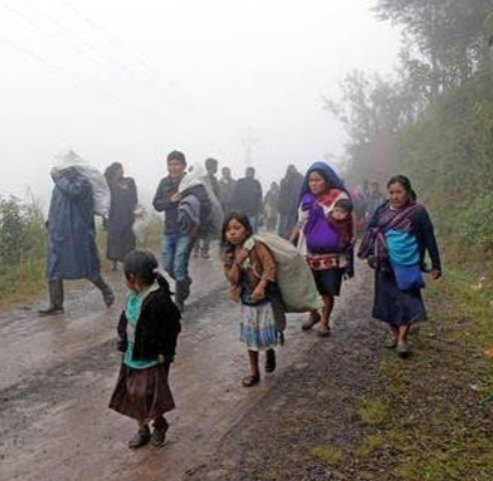
By Luis Hernandez Navarro
In November, the coffee bushes of Aldama, Chiapas are dressed in red. The cherries of the aromatic fruit reach optimal maturity. Right then, the coffee growers must pick the grains by hand, one by one, leaving the green ones for later. If the fruits remain on the bush longer, their color changes and they acquire a bitter, vinegary taste.
But this November, Aldama’s small producers cannot harvest their coffee. Nor were they able to harvest it in its entirety last year, or in 2018. Doing so puts their lives at risk. When they walk to their plots, the paramilitaries of Santa Martha shoot to kill, with weapons exclusively for Army use. So they have to avail themselves of the darkness of night to milk the shrubs of a few fruits. The violence against them, present every month since 2017, intensifies during the harvest season.
For coffee growers, not picking the fruit is ruin. With the very few profits that they make from its sale, they earn the money necessary to acquire the products that the milpa doesn’t yield. If they don’t sell the grain, they have no income. This is what has happened to the coffee growers of Aldama over the past three years.
The same is true for the women who dedicate themselves to artisanry. Not only were they displaced from their communities alongside their children and their parents. They spend every day between bursts of projectiles, fearing for theirs and their loved ones’ lives, without being able to go out to work.
According to the Fray Bartolomé de las Casas Center for Human Rights, as of the 19th of Septiembre there had been 628 acts of intimidation and aggressions with firearms. As Ernesto Ledesma and Rompeviento..TV have documented, the authorities have not intervened to prevent the attacks, on the contrary, the state police have supported the paramilitaries of Santa Martha. These attacks have forced the residents of Aldama to build walls of concrete to protect themselves from bullets. They have even erected parapets in the schools (https://bit.ly/2HoNZ6W).
Starting in March of 2018, the paramilitary offensive caused the forced displacement of 2 thousand people from 13 communities. The people of Aldama have had houses, personal belongings, land, cornfields, orchards, animals, and the right to live in peace taken away from them. Every day and every night hundreds of women and children live in the mountains, under threat of something bad happening to them. Hunger is their constant companion. (https://bit.ly/3lR1RG9).
Aldama is a small Tzotzil municipality in the Altos (Highlands) of Chiapas, with its municipal seet in Santa María Magdalena, which arose out of the remunicipalisation of 1999, pushed by the government of Roberto Albores, El Croquetas (his nickname), to confront the Zapatista expansion. During the 19th century it had the ranking of a municipality until it was subordinated to San Pedro Chenalhó in 1921. (https://bit.ly/2KAUo0l).
The aggressors belong to the neighboring ejido of Santa Martha, in Chenalhó. In 1975, the Secretary of Agrarian Reform improperly allocated 60 hectares to Santa María Magdalena. Thus began, with a governmental error, a long agrarian litigation, aggravated over the years by a mixture of government partiality and neglect. In 2008, the Unitary Agrarian Tribunal, (TUA) ruled in favor of Aldama for the 60 hectares. However, Santa Martha rejected the court’s decision.
But the Aldama- Santa Martha conflict is not the only one in the region. Within Santa Martha there itself, there is an internal conflict that has caused deaths, starting with the liberation of the paramilitaries that perpetrated the massacre of Acteal. There is a strong lawsuit between the former mayor of Chenalhó, Rosa Pérez, and the former trustee who lives in Santa Martha.
Over the years, agreements of peaceful coexistence have been negotiated and reached that are not fulfilled (https://bit.ly/3pQVq8v). Meanwhile in the region, the businesses of stripping stolen vehicles (of good make and recent vintage), weapons trafficking and sales, piracy, and drug dealing flourish. These activities reveal the presence of organized crime groups, with national connections, that seek territorial control for their operations and can only act with the conspiracy of authorities -groups who are hindered by Zapatista autonomy and indigenous communities.
In Santa Martha, a paramilitary group with high-powered weapons and capacity and resources to harass an entire municipality daily, acts with impunity, unimpeded by the authorities. To assume that there is a paramilitary operation of this magnitude for a conflict over 60 hectares, is to say the least, naive. Of course, the agrarian problem exists and has to be resolved. But it is not limited to that. The revival of intercommunity disputes is part of the manual for the counterinsurgency warfare. Aldama is no exception.
More: Since 2006 in Oaxaca, with the struggle of the APPO, civil authorities have subcontracted counter insurgency tasks which the Army and police had previously been responsible for to groups of organized crime. The model has been extended, at least to Guerrero, Michoacán and Baja California. (https://bit.ly/398LmS7). All of this seems to indicate that it also is at work in Chiapas, where there is a long relationship between institutional politics (the Chiapas family reloaded) and criminal activity, like the trafficking of migrants and the shuffling of drugs.
This piece was originally published in Spanish in La Jornada on November 23rd, 2020. https://www.jornada.com.mx/2020/11/23/opinion/026a1pol This English interpretation has been re-published by Schools for Chiapas with permission from Chiapas Support Committee Oakland.
